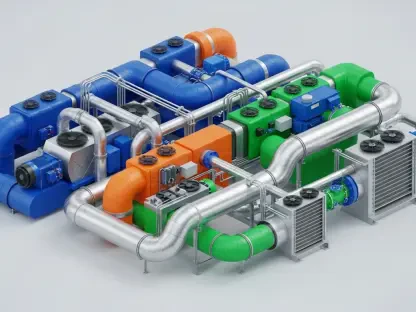Texas has long stood as a titan in the American manufacturing landscape, fueling economic progress with its robust industrial base and innovative spirit. However, recent findings from the Texas Business Outlook Surveys, conducted between August 12–20 of this year, reveal a sector at a crossroads. Drawing from the insights of 331 business executives across manufacturing, service, and retail sectors, the data highlights a complex mix of cautious optimism and formidable challenges. Among these, the introduction of higher tariffs in the current year emerges as a dominant concern, casting a shadow over growth prospects. This article explores the intricate ways these trade barriers are reshaping the environment for Texas manufacturers, while also examining related economic trends such as demand expectations and pricing dynamics that influence the sector’s trajectory. By delving into the survey results, a clearer picture emerges of how external pressures are testing the resilience of an industry critical to the state’s economy.
The Weight of Tariffs on Manufacturing
The introduction of higher tariffs this year has struck a significant blow to Texas businesses, with manufacturing bearing the brunt of the impact. According to the recent surveys, a staggering 47.7% of firms across all sectors report negative effects from these trade policies, while a mere 2.1% see any benefit. For manufacturers, the situation is even more dire—over 70% of these firms are grappling with adverse consequences, far outpacing the 60% of retail businesses affected. The ripple effects are evident in multiple areas: nearly half of all companies cite skyrocketing input costs, 27% have been forced to raise selling prices, and close to 40% are dealing with compressed profit margins. For a sector heavily reliant on global supply chains, these tariffs represent not just a financial strain but a fundamental challenge to maintaining competitive operations in an already demanding market.
Beyond the immediate cost burden, tariffs are disrupting the very core of manufacturing activities in Texas. The surveys indicate that 21% of affected firms have experienced a drop in production or sales directly attributable to these trade barriers, while only a negligible 5% report an increase in output. This imbalance paints a sobering picture of an industry struggling to adapt under pressure. Company outlooks have taken a noticeable hit, with pervasive negativity clouding future expectations. For Texas manufacturers, who often depend on imported raw materials and components, these policies are more than a temporary setback—they pose a serious threat to sustaining the growth momentum that has defined the sector’s role in the state’s economic fabric, raising questions about long-term viability without strategic interventions.
Strategies to Counter Tariff Challenges
In response to the mounting costs brought on by tariffs, Texas businesses are deploying a range of strategies to mitigate the damage. Among those impacted, 48% have opted to pass a portion of the increased costs onto customers, while 39% have absorbed the financial hit internally, often at the expense of their profit margins. Other proactive measures include accelerating purchases before tariffs fully took effect, a tactic adopted by 37% of firms, as well as seeking alternative suppliers—23.7% have turned to domestic sources, and 16.7% to foreign ones. Looking ahead, the focus remains on passing costs through to customers (31.9%) and prioritizing domestic suppliers (23.7%), though only about 20.9% of companies manage to transfer the full cost burden, with most bearing a significant share themselves to avoid alienating their market base.
The timing of these responses adds another layer of complexity to the situation. Nearly half of the surveyed businesses adjusted their pricing strategies swiftly, either upon the announcement of tariffs or within a month of their implementation. However, delays are frequent, driven by uncertainties surrounding the final scope of costs and doubts about whether customers will tolerate higher prices. This hesitation reflects a deeper caution among Texas manufacturers, who are keenly aware of the competitive landscape they operate within. The risk of losing market share looms large, prompting a delicate balancing act between cost management and customer retention, a dynamic that could shape decision-making for the remainder of the year as firms navigate this turbulent economic terrain.
Demand Forecasts and Cautious Optimism
Despite the challenges posed by tariffs, there remains a thread of optimism within the Texas manufacturing sector regarding future demand. Survey respondents, particularly in manufacturing, express a stronger belief in improved demand for their goods over the next six months, excluding seasonal fluctuations, compared to their counterparts in retail and service sectors. This positive sentiment underscores the sector’s underlying strength and its critical role as a driver of economic activity in the state. However, this optimism is not without reservation—since February of this year, the gap between firms anticipating growth and those expecting a decline has narrowed, signaling a more tempered outlook than in earlier months. This shift suggests that while potential for expansion exists, external pressures are tempering expectations.
The nuanced demand forecast highlights a broader trend of cautious hope among Texas manufacturers. While the sector appears poised for growth compared to other industries, the tempered confidence reflects an awareness of the hurdles ahead. Factors such as global economic conditions, consumer behavior, and ongoing trade policy uncertainties contribute to this restrained outlook. For manufacturing firms, sustaining growth will likely depend on their ability to navigate these complexities while capitalizing on anticipated demand increases. The survey data indicates that despite a promising foundation, the path forward is fraught with challenges that require adaptive strategies and possibly supportive policies to ensure that positive demand expectations translate into tangible economic gains for the state’s industrial base.
Declining Pricing Power and Market Pressures
Compounding the tariff-related difficulties, Texas businesses are facing a notable decline in pricing power. Over the past three months, a greater number of firms have reported challenges in raising prices compared to those finding it easier, a trend that spans across manufacturing, retail, and service sectors. For manufacturers, this reduced ability to pass on cost increases—whether stemming from tariffs or other operational expenses—intensifies financial pressures. The competitive nature of the market, coupled with consumer resistance to higher prices, likely plays a significant role in this dynamic, forcing many companies to operate on thinner margins while striving to maintain their position in a crowded field.
This erosion of pricing power presents a critical challenge for Texas manufacturers, who must balance profitability with market competitiveness. The inability to fully transfer cost burdens to customers risks stifling investment in innovation or expansion, areas vital for long-term growth. Additionally, this trend signals a shift in market dynamics, where consumer sensitivity to price changes could dictate strategic decisions more than ever before. As firms grapple with these constraints, the broader implication is a potential slowdown in the sector’s ability to drive economic progress, particularly if external cost pressures like tariffs persist. Addressing this issue may require a deeper look into cost efficiencies or alternative revenue strategies to offset the limitations imposed by a resistant pricing environment.
Sectoral Variations and Manufacturing’s Heavy Load
The survey results also reveal stark differences in how economic pressures, particularly tariffs, impact various sectors in Texas. Manufacturers, despite holding stronger demand expectations, face the most severe consequences from trade barriers due to their heavy dependence on imported inputs and materials integral to production processes. Retail businesses, while also significantly affected (with 60% reporting negative tariff impacts), must contend with direct consumer pushback against price increases, adding another layer of difficulty. In contrast, service sector firms appear somewhat insulated, likely due to less reliance on imported goods, experiencing milder effects from these trade policies.
This sectoral disparity underscores the unique burden placed on Texas manufacturing, positioning it as the most vulnerable to external economic shocks. The reliance on global supply chains amplifies the impact of tariffs, creating a ripple effect that touches everything from cost structures to production levels. Meanwhile, the varying degrees of impact across industries highlight the need for targeted approaches to address these challenges. For manufacturing, solutions may involve diversifying supply sources or advocating for policy adjustments, while other sectors might focus on consumer engagement strategies. Understanding these differences is crucial for crafting effective responses that bolster the state’s overall economic resilience, with particular attention to protecting the industrial backbone that manufacturing represents.
Navigating the Road Ahead
Reflecting on the insights gathered from the Texas Business Outlook Surveys conducted in August, it becomes evident that the manufacturing sector, while a pillar of economic strength, has encountered significant headwinds. Tariffs introduced earlier in the year have reshaped the operational landscape, burdening over 70% of manufacturers with increased costs and reduced margins. The decline in pricing power has further compounded these struggles, as firms find it increasingly difficult to offset expenses in a competitive market. Responses vary, with many opting for partial cost pass-through or seeking alternative suppliers, though uncertainties often delay decisive action.
Looking forward, Texas manufacturers must prioritize strategic planning to mitigate ongoing tariff impacts, exploring options like supply chain diversification or enhanced cost efficiencies. Policymakers could play a pivotal role by considering measures to ease trade-related pressures, ensuring the sector’s growth potential isn’t stifled. Collaborative efforts between businesses and government might offer innovative solutions, safeguarding manufacturing’s vital contribution to the state’s economy while adapting to an evolving global trade environment.









